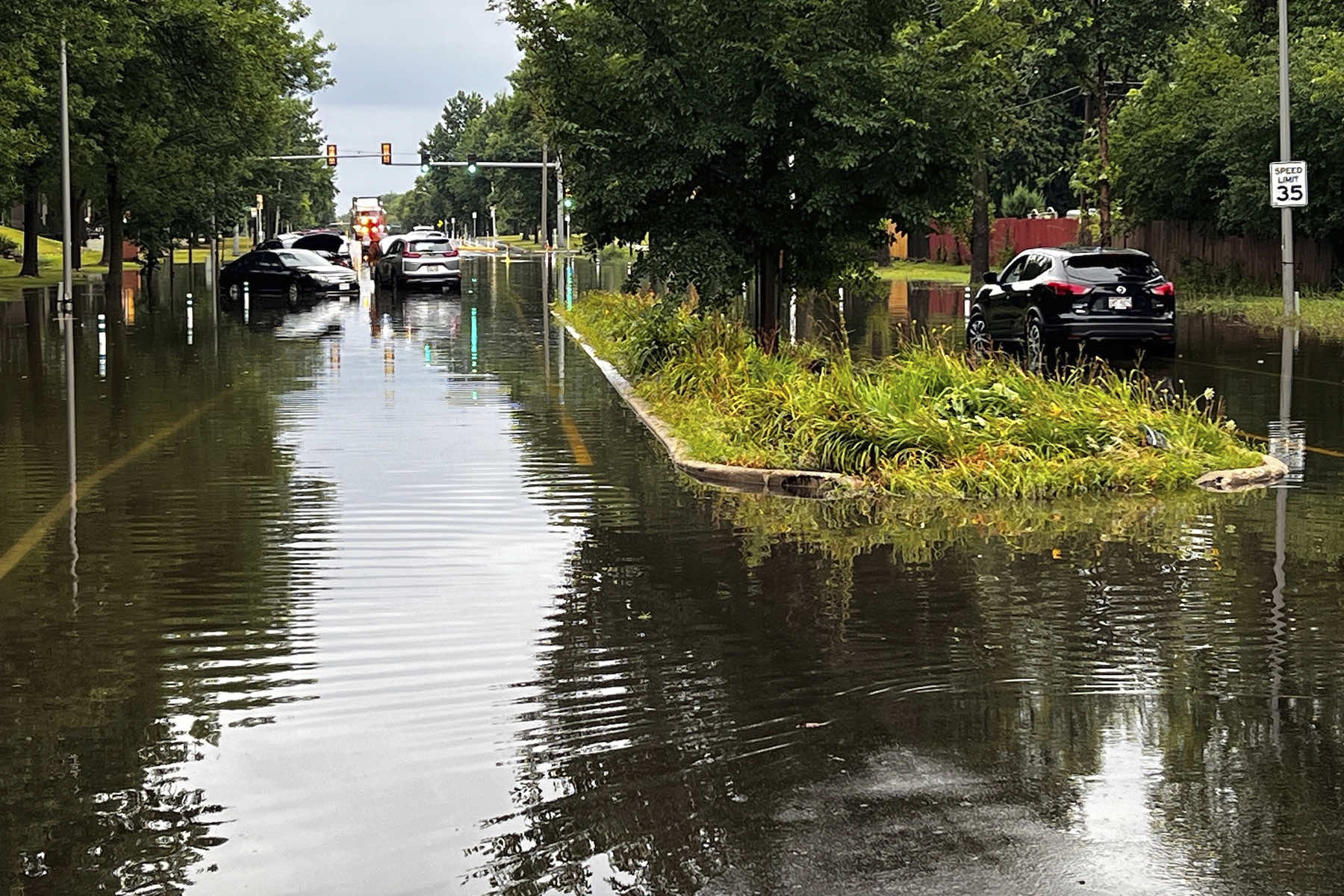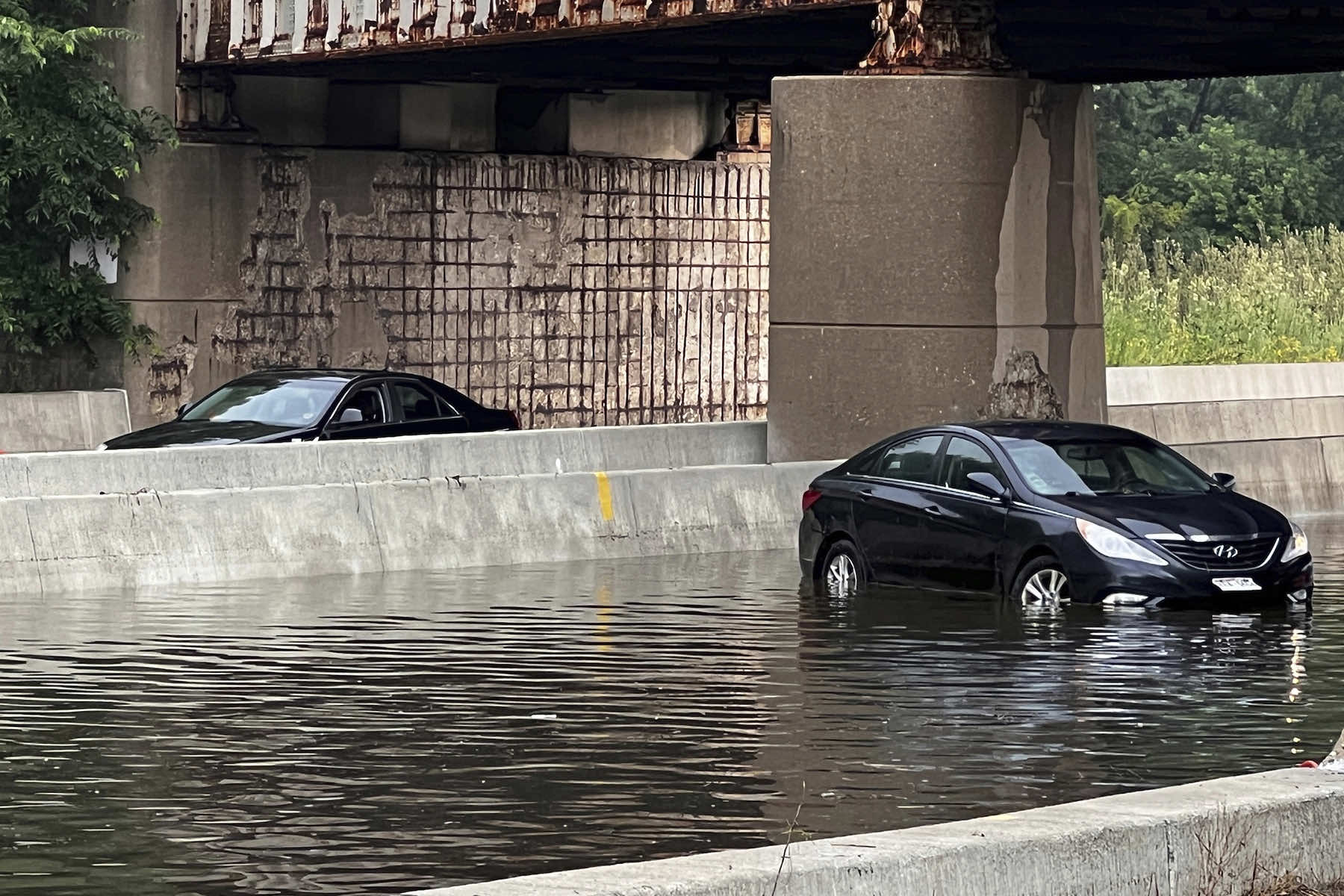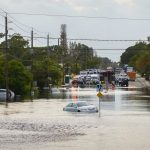
Historic rainfall over the weekend of August 9 and 10 swamped Milwaukee County with record-breaking floods, prompting the cancellation of the final day of the Wisconsin State Fair, cutting power to tens of thousands, and leaving emergency crews scrambling to handle hundreds of calls for help.
The deluge, which began on August 9, dumped as much as 12 inches of rain in parts of the metro area, overwhelming drainage systems and submerging streets, basements and parks. The National Weather Service reported the Milwaukee River cresting at a record 11.19 feet, surpassing the 10.48-foot mark set in July 2010.
City officials said they had not received reports of flood-related deaths as of August 10, but the toll on property and infrastructure was extensive. Fire crews alone responded to more than 600 calls overnight, including 65 water rescues, natural gas leaks, electrical hazards, and multiple structure fires.
“This flooding event is very significant. It’s something that Milwaukee hasn’t seen in perhaps a decade or more,” said Mayor Cavalier Johnson at an August 10 press conference. “My heart goes out to everyone dealing with basement flooding, power outages, damage to cars, trees that were uprooted in and around their properties and a list of other things. I’m grateful that as of now there’s been no death associated with these floods.”
Mayor Johnson said city agencies — including the fire and police departments, public works and emergency management — had been “active and without interruption since this event started.” He noted his administration was in contact with the governor’s office in Madison and working closely with Milwaukee County to coordinate shelter operations and other resources for residents.
“Earlier today, I approved Wisconsin National Guard vehicles and operators to help support Milwaukee County’s response to severe flooding that affected the region last night. We are continuing to monitor flooding, especially as several counties continue to remain under flash flood warnings,” said Governor Tony Evers in a statement. “My office has been in contact with local officials throughout the day today to offer state assistance wherever we can. I want to thank all of the emergency and first responders and local officials who’ve been working around the clock to respond.”
Milwaukee County Executive David Crowley also declared a state of emergency on August 10 in coordination with local and state emergency management officials. The move authorized the deployment of additional resources and allows the county to activate state and federal partners to assist in the response.
“Our top priority remains the life and safety of Milwaukee County residents,” said County Executive Crowley. “I’ve had a chance to tour some of the damage and have been without power myself, so I want folks to understand that we see and hear you when it comes down to the damage and devastation.”
The floods forced the early closure of the Wisconsin State Fair in West Allis, which had been scheduled to wrap up its 11-day run on August 10. Fair organizers said in a statement that the decision was “the best” given current conditions and forecasts. Rock band Lynyrd Skynyrd’s planned performance at the fair was also canceled.
Other major events were affected, including the USA Triathlon Sprint and Paratriathlon National Championships, which were called off. The Milwaukee Brewers’ home game against the New York Mets went ahead despite the parking lot being inaccessible to traffic.
Milwaukee Fire Chief Aaron Lipski said his department’s workload peaked between 8 p.m. on Saturday, August 9, and 7 a.m. on Sunday, August 10, with calls ranging from submerged vehicles to downed power lines. The department, he said, was “tapped out very, very early” and relied on assistance from about a dozen fire departments from Racine, Ozaukee, Washington, and Waukesha counties.
“We pulled dozens of people out of cars and off of cars trapped in the middle of floodwaters,” said Chief Lipski. “This floodwater may look like it’s not moving much, but it can have a strong current. And when you get these excessive floods, the water pressure in the sewer system can actually lift the lids off manholes. There’s not a whole lot of coming back from that if you fall in.”
Chief Lipski also warned residents to avoid entering flooded basements where water levels were above the knee because of electrocution hazards, and to have electric or hybrid vehicles checked before use if they had been submerged.
Public works crews toiled through the night to clear surface flooding, open blocked waterways, and tow disabled vehicles. Commissioner of Public Works Gerald Kresge said the city would open its drop-off centers, normally closed on Mondays, for flood debris disposal and waive fees for the week.
“We do appreciate the help of opening up catch basins, but we want to remind folks to be very, very careful,” said Kresge. “There are electrical lines down, street lights and traffic signals damaged. We want to make sure people are not putting themselves in harm.”
The flooding also exposed a chronic problem with street litter and blocked storm drains, officials said. Alderman Mark Chambers said cleanup crews found “extreme amounts of trash” clogging sewer grates, which contributed to street flooding.
“This is a prime example of why we need to care about our communities,” said Alderman Chambers. “Please, Milwaukee, take care of your community so we won’t run into situations like this.”
The National Weather Service issued multiple flash flood warnings for southeast Wisconsin through Monday, August 11, with more rain in the forecast. By the evening of August 10, nearly 47,000 We Energies customers remained without power in Milwaukee and surrounding counties.
Public health officials also warned of hazards from contaminated water. City Health Commissioner Mike Totoraitis said floodwater could contain chemicals, debris, and raw sewage.
“If you have to go into floodwater, whether that’s in your basement or outside, make sure you’re wearing protective equipment — boots, gloves, goggles — and wash your hands thoroughly afterward,” said Commissioner Totoraitis. “If you have open wounds, clean them immediately and monitor for signs of infection. And assume any food or medication stored in a flooded area has been contaminated and should be thrown away.”
The storm’s intensity left even seasoned emergency managers grappling with its scope. Ryan Zolikoffer, the city’s emergency management director, said preliminary assessments were underway to determine whether the damage met state and federal thresholds for disaster relief funding.
“We’ve reached out to the county as well as to the state emergency management agency,” said Zolikoffer. “They’re going to send out an incident management team to do a preliminary assessment of the conditions and financial costs. Based on certain thresholds, we’ll determine whether we’re eligible for those funds.”
According to Zolikoffer, Milwaukee’s Emergency Operations Center had been open since August 9 and would remain staffed as disaster recovery continued. He urged residents to call 211 to report property damage so officials could compile a comprehensive cost summary for the state.
The speed and volume of the rainfall overwhelmed the region’s stormwater systems. In one location, Johnson said, 14 inches fell in a short span, an amount no sewer system could handle. The result was water surging into basements, overflowing rivers and streams, and pooling in low-lying streets.
The Menomonee River in Wauwatosa swelled past its banks, submerging a popular playground. City crews and volunteers worked to clear debris from catch basins to help stormwater drain, but in many areas, the sheer force of the river flooding rendered those efforts moot.
“This was an intensity issue,” said Mayor Johnson. “The volume came so fast there was no way to move it all out before it caused flooding.”
The flooding’s reach extended to Milwaukee Mitchell International Airport, where underpass tunnels, taxiways, and runways were inundated, according to the weather service. Officials reported significant delays and urged travelers to check with airlines before arriving at the airport.
County Executive Crowley said the county had also coordinated with the American Red Cross to open emergency shelters on Milwaukee’s south side. The shelters were intended for residents forced from their homes by flooding or power outages.
“I want to thank our first responders, law enforcement partners, social service workers, and neighbors who have been lending a helping hand,” added County Executive Crowley. “In moments like these, community matters more than ever.”
The scale of the damage was evident in the fire department’s call logs. Beyond water rescues, firefighters responded to multiple blazes triggered by electrical malfunctions caused by water intrusion, a second-alarm fire in a 10-story cold storage building, and another blaze on Industrial Road.
“There are hundreds of vehicles around the city blocking intersections, making progress absolutely impossible,” added Chief Lipski, voicing frustration at drivers who ignored the flood warnings. “We can’t do everything. We can’t be everywhere at once. We need the public’s help.”
Lipski credited mutual aid from surrounding counties for helping the city get through the night. The department even split its dive team in half to cover more rescue calls.
The storm system that struck Milwaukee was part of a broader severe weather outbreak stretching across the Midwest. The same front produced winds exceeding 80 mph in Nebraska, where a falling cottonwood tree killed one person and seriously injured another.
Forecasters said repeated waves of heavy rain were possible into August 11, raising the risk of additional flooding. Mayor Johnson urged residents to stay vigilant and prepare for prolonged recovery efforts.
“This isn’t something we fix overnight,” he said. “We’re still in the middle of it, and we’re still catching up.”
While the weather service expected rainfall to taper off, the lingering high water levels in rivers and saturated ground posed ongoing risks. Officials said it could take days for floodwaters to fully recede, and longer still for residents to restore homes and businesses.
For many, the images of submerged cars, waterlogged homes, and uprooted trees were a reminder of the city’s vulnerability to extreme weather events.
“These leaders have been working all night and around the clock on this issue. They are working to keep our community safe in order to make sure that the streets again become passable,” added Mayor Johnson. “We are encouraging people in our community to be safe as well.”
© Photo
CBS28/WDJT (via AP)

















